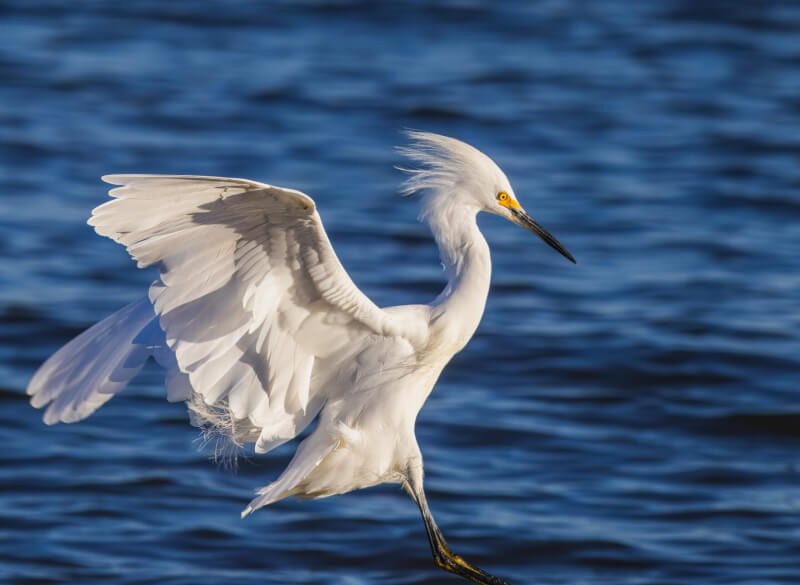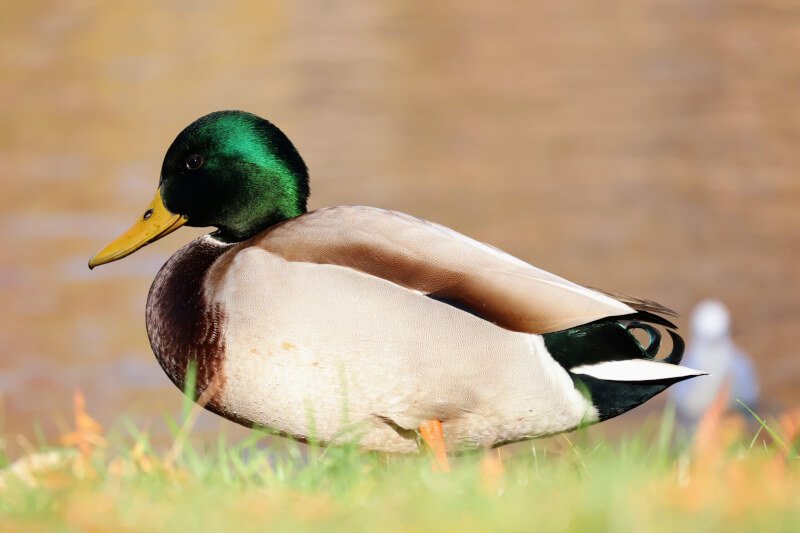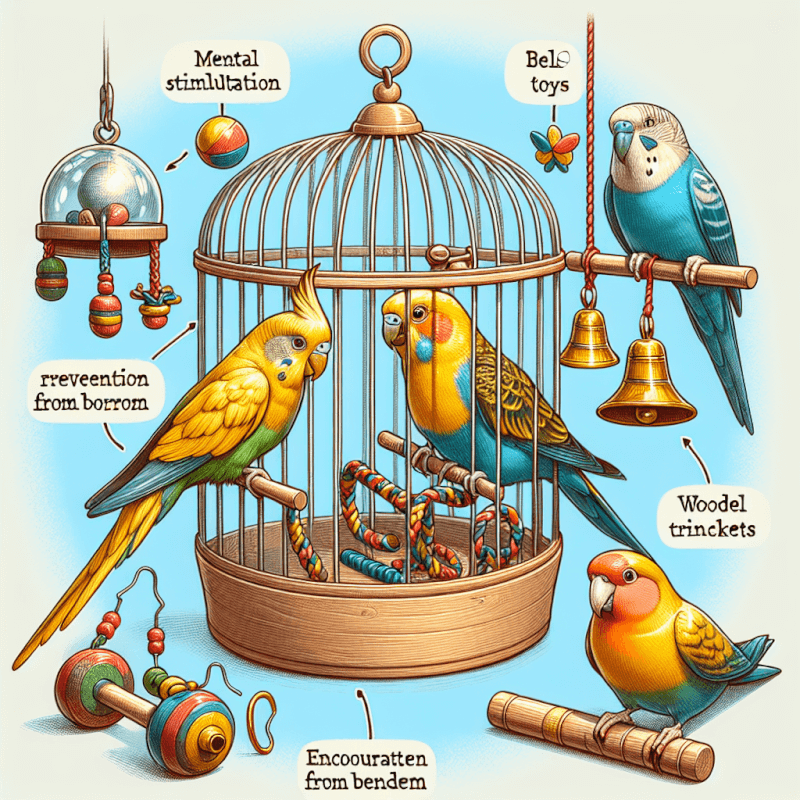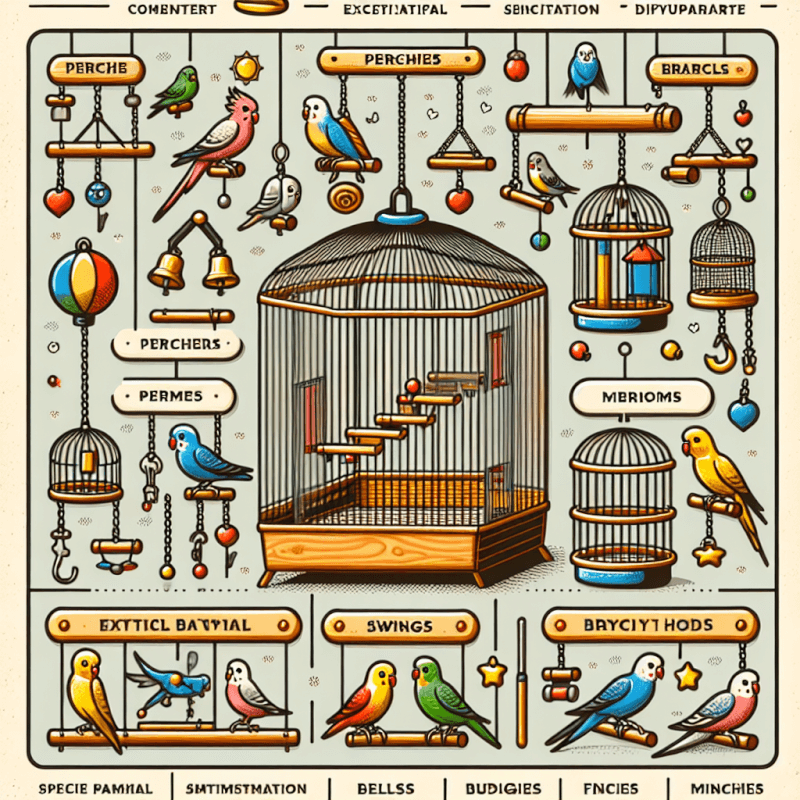Have you ever wondered do birds need toys in their cages? Many bird owners struggle with this question, unsure of what their feathered friends truly need for mental stimulation and physical exercise. While providing a spacious cage, nutritious food, and fresh water is essential, the importance of toys should not be underestimated. Birds are highly intelligent creatures that thrive on interaction and mental stimulation, and toys can provide them with both. In this article, we will explore the benefits of toys for birds and why they should be an essential part of their environment.

The Importance of Toys for Birds
Physical Stimulation
Toys play a vital role in providing physical stimulation to birds. They allow birds to exercise and stay physically active, which is crucial for their overall health and well-being. Toys that encourage movement, such as swings, ladders, and climbing ropes, help birds develop their coordination and strengthen their muscles. By engaging in physical play, birds can burn off excess energy and maintain a healthy weight.
Ready for Cat Trivia?
Test your knowledge about cats!

Mental Stimulation
Birds are intelligent creatures that require mental stimulation to thrive. Toys that challenge their cognitive abilities and problem-solving skills help keep their minds sharp and stimulated. Puzzle toys, for example, require birds to figure out how to unlock hidden treats or solve puzzles to receive rewards. These toys not only entertain birds but also prevent boredom and mental stagnation.
Behavioral Enrichment
Providing toys for birds is essential for their behavioral enrichment. In their natural habitats, birds exhibit a range of behaviors, such as foraging, exploring, and socializing. Keeping birds in captive environments can limit their opportunities to engage in these natural behaviors. However, by providing appropriate toys, we can mimic aspects of their natural environment and encourage their natural behaviors. Toys that simulate foraging, such as puzzle feeders or foraging toys filled with treats, allow birds to engage in instinctive behaviors and keep them mentally and physically enriched.
Prevention of Boredom
Boredom can lead to a range of behavioral issues in birds, including feather plucking, aggression, and excessive vocalization. Toys play a crucial role in preventing boredom by providing birds with entertainment and stimulation. When birds have access to toys, they can redirect their energy and focus on engaging with their environment. This helps reduce stress and promotes a positive mental state. With an enriched and stimulating environment, birds are less likely to develop negative behaviors caused by boredom.
Choosing the Right Toys
Safety Considerations
The safety of toys should always be a top priority when choosing toys for your birds. Avoid toys with small parts that can be easily swallowed or become a choking hazard. Ensure the toys do not contain toxic materials, such as lead or zinc. Opt for toys made from bird-safe materials, such as sturdy plastics or untreated wood. Regularly inspect toys for any signs of wear and tear, and replace them if they become damaged. Safety is essential in ensuring the well-being of your feathered friend.
Variety of Toys
Providing a variety of toys is crucial to keep your bird engaged and entertained. Different birds have different preferences, so offering a variety of toys ensures there is something for everyone. Consider providing toys that offer different types of stimulation, such as toys for climbing, chewing, swinging, or shredding. Rotating toys regularly can also help maintain your bird’s interest and prevent boredom.
Size and Texture
Choose toys that are appropriate for your bird’s size. Toys that are too small can pose a choking hazard, while toys that are too big may be difficult for the bird to manipulate. Consider the texture of the toys as well. Birds enjoy toys that provide different textures to explore, such as soft fabric, hard plastic, or natural wood. Variety in size and texture adds to the overall enrichment value of the toys.
Interactive Toys
Interaction is key when it comes to choosing toys for your bird. Interactive toys, such as treat-dispensing toys or toys that require manipulation, encourage birds to actively engage with their toys. These toys help stimulate their problem-solving abilities and provide a sense of accomplishment when they successfully interact with them. Interactive toys also promote social interaction, as they can be enjoyed with the bird’s human companions or other bird companions.
DIY Toy Ideas
Paper Roll Toys
Empty paper rolls from toilet paper or paper towels can be repurposed into simple yet engaging toys for birds. Stuff them with bird-safe materials, such as shredded paper or small treats, and fold the ends to create a foraging toy. Birds will enjoy unraveling the roll to get to the hidden surprises inside.
Puzzle Toys
Creating puzzle toys for birds can be an exciting DIY project. Use cardboard or plastic containers to create compartments. Hide treats or toys within these compartments, and provide the bird with opportunities to figure out how to access the rewards. This engages their problem-solving abilities and provides mental stimulation.
Foraging Toys
Foraging toys mimic the behavior of birds finding food in the wild and encourage them to engage in natural foraging behaviors. Create foraging toys by hiding treats or seeds within various materials, such as wrapped newspaper, folded paper, or paper bags. This stimulates the bird’s natural search for food and keeps them mentally stimulated.
Natural Materials
Using natural materials to create toys for birds can be both fun and enriching. Collect safe materials, such as untreated branches, pinecones, and seagrass, and assemble them into toys that promote chewing and exploration. Natural materials provide birds with a taste of their natural environment and can keep them engaged for hours.
Common Mistakes to Avoid
Using Unsafe Materials
One common mistake is using unsafe materials when making or purchasing toys for birds. Ensure that all materials used in toys are bird-safe and free from toxins. Avoid toys with small parts that can be easily ingested or become lodged in a bird’s throat. Always check for safety hazards before giving a toy to your feathered friend.
Providing Inadequate Variety
Another mistake to avoid is not providing enough toy variety. Offering the same toys repeatedly can lead to boredom and disinterest. To keep your bird entertained, have a selection of toys that provide different forms of stimulation, including climbing toys, puzzle toys, and toys with various textures. Rotate the toys regularly to maintain your bird’s interest and prevent monotony.
Neglecting Toy Maintenance
Neglecting to regularly inspect and maintain toys is a common oversight. Over time, toys can become worn out or damaged, posing potential risks to your bird’s safety. Regularly check for frayed ropes, loose parts, or signs of wear and tear. Replace any toys that show signs of damage to ensure your bird’s safety and enjoyment.
Introducing Toys to Birds
Gradual Introduction
When introducing new toys to your bird, it is essential to do so gradually. Some birds may be wary of new objects, so giving them time to observe and become familiar with the toy before placing it directly in their cage is crucial. Start by placing the toy near their cage and observe their reaction. Once they grow accustomed to the presence of the toy, gradually move it closer to their cage until they feel comfortable interacting with it.
Positive Reinforcement
Positive reinforcement is an effective way to encourage birds to interact with toys. Use treats or praise to reward your bird when they show interest in a new toy. This positive association helps them understand that playing with toys is a rewarding experience. Take the time to engage with your bird and their toys, as this can also encourage them to explore and play.
Observing Bird’s Preferences
Every bird has unique preferences, so it’s essential to observe and understand what types of toys your bird enjoys. Some birds may prefer toys that they can shred or chew on, while others may enjoy swinging or climbing toys. Take note of your bird’s behavior and engagement with different types of toys, and cater to their preferences when selecting new toys for them.
Monitoring Bird’s Response to Toys
Engagement and Playfulness
One way to determine if your bird is responding positively to toys is through their engagement and playfulness. If your bird actively interacts with their toys, such as climbing on them, chewing them, or manipulating them, it is a sign that the toys are engaging and stimulating for them. Birds that show curiosity and enthusiasm towards their toys are generally benefiting from the enrichment they provide.
Destructive Behaviors
If your bird exhibits destructive behaviors towards their toys, such as excessive chewing or tearing them apart, it is usually a positive sign. Birds have a natural instinct to chew and shred, and providing appropriate toys helps redirect these behaviors onto objects that are safe for them. However, it is crucial to ensure that the toys are made from bird-safe materials and that your bird is not ingesting any harmful parts.
Overall Well-being
By monitoring your bird’s overall well-being, you can gauge the effectiveness of the toys in their environment. Happy and content birds that engage with their toys are generally more vibrant, active, and show fewer signs of stress or boredom. On the other hand, birds that show signs of lethargy or exhibit negative behaviors, such as feather plucking or excessive vocalization, may indicate a lack of adequate toys or a need for a change in toy selection.

Toys for Different Bird Species
Parrots and Cockatoos
Parrots and cockatoos are highly intelligent and active birds, requiring a wide variety of toys to keep them physically and mentally stimulated. Toys that provide challenges, such as puzzle toys or foraging toys, are especially suitable for these birds. Additionally, providing large toys that they can climb on, swing from, or chew will help fulfill their natural instincts.
Canaries and Finches
Canaries and finches, although smaller in size, still benefit from toys in their cages. They enjoy toys that allow them to exercise their natural instincts, such as toys that encourage flight or simulate natural perching. Toys with bells or mirrors can also provide entertainment for these social birds.
Budgies and Cockatiels
Budgies and cockatiels are highly social and intelligent birds that require mental stimulation and interaction with toys. Toys that can be manipulated, such as puzzle toys or interactive toys that produce sounds, are ideal for these birds. They also enjoy toys they can climb on, swing from, or dismantle.
Lovebirds and Parakeets
Lovebirds and parakeets are playful and active birds that enjoy exploring and interacting with their environment. Toys that they can chew on or dismantle, such as toys made from bird-safe materials like untreated wood or shreddable materials, are popular choices for these birds. They also enjoy toys they can swing from or toys that produce sounds.
Toys for Specific Needs
Aging Birds
As birds age, their toy preferences and abilities may change. Soft and comfortable toys that provide sensory stimulation, such as fabric toys or toys with different textures, are suitable for aging birds. Toys that encourage gentle exercise, such as toys to manipulate or toys that promote balance, can also be beneficial for older birds.
Hand-Raised Birds
Hand-raised birds may require extra attention and care when it comes to toy selection. Toys that imitate natural behaviors, such as foraging toys or toys that simulate flying, can help these birds transition into independent play. Providing a variety of toys that they can manipulate and explore will help them develop their physical and mental abilities.
Rescued Birds
Rescued birds may come from challenging backgrounds, and toys can play a significant role in their rehabilitation and emotional well-being. Soft, comforting toys can provide a sense of security, while interactive toys can help build trust between the bird and its caregiver. Slowly introducing appropriate toys and observing the bird’s response is crucial when dealing with rescued birds.
Sick or Injured Birds
When birds are sick or injured, their levels of activity may decrease. However, providing them with toys that cater to their abilities and limitations can still be beneficial. Gentle manipulation toys or soft toys that provide comfort are often suitable for sick or injured birds. Observing the bird’s response and adjusting the toys accordingly is essential to ensure their well-being.

Budget-Friendly Toy Options
Household Items
Many household items can be repurposed into bird toys. Empty cardboard boxes, plastic bottle caps, or old keys can be safely incorporated into toys for birds to explore and manipulate. Ensure that these items are bird-safe, clean, and free of any sharp edges or potential hazards.
Nature-inspired Toys
Nature can provide an abundance of materials for making budget-friendly bird toys. Pinecones, dried grasses, or branches can be transformed into toys that encourage chewing, climbing, or foraging. Make sure to collect materials from pesticide-free areas and sanitize them before use.
DIY Projects
Engaging in DIY projects can save you money while providing customized toys for your bird. Simple projects, such as knotting together strips of fabric or creating paper roll toys, can be fun and fulfilling. Online resources and tutorials can provide inspiration for creating unique and engaging toys.
Second-hand Toys
Bird toys can be expensive, but you can find more affordable options by exploring second-hand stores or online marketplaces. Gently used toys can still be safe and entertaining for your bird. Thoroughly clean and inspect these toys before introducing them to your bird’s environment.
Do Birds Needs Toys In Their Cages? Conclusion
Toys play a vital role in the physical, mental, and behavioral enrichment of birds kept in captivity. By providing appropriate toys, birds can stay physically and mentally stimulated, prevent boredom, and engage in natural behaviors. Choosing the right toys involves considering safety, variety, size, and interactivity. DIY toy ideas offer budget-friendly alternatives, while monitoring a bird’s response to toys ensures their well-being. Different bird species and specific needs require different types of toys, and budget-friendly options such as household items and nature-inspired toys are available. Toys are not just a luxury for birds; they are a necessity that promotes their overall health and happiness. So, make sure to invest in toys that will bring joy and enrichment to your feathered friends.



